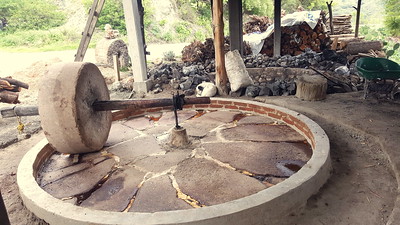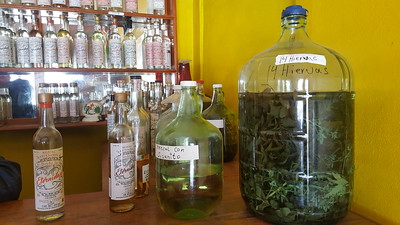Carsona Oaxaca manager Francisco arranged for a friend of his to pick us up at the hotel for our much anticipated return to the surrounding Oaxaca countryside to visit some of our favorite palenques. Our first destination was the village of San Lorenzo Albarradas. Upon arriving in the town, we took the old road towards Mitla and after about 15 minutes up one side and then heading down the other side of a mountain we rounded a curve and found what we were looking for: Mezcal Zompantle.
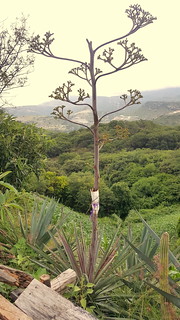 The shelter improvements that were underway on our last visit had been completed but the place still held the charm that so impressed us our previous visits. Part of that warm feeling is its location on the side of a mountain with gorgeous views of the countryside all the way to Mitla in the valley below. The tasting table is still out front while the grinding wheel, in-the-ground wood-fired pit and copper still we remembered were still there but are now under the newly covered area.
The shelter improvements that were underway on our last visit had been completed but the place still held the charm that so impressed us our previous visits. Part of that warm feeling is its location on the side of a mountain with gorgeous views of the countryside all the way to Mitla in the valley below. The tasting table is still out front while the grinding wheel, in-the-ground wood-fired pit and copper still we remembered were still there but are now under the newly covered area.
Of all the palenques we’ve visited, Zompantle is among the more rustic operations yet at the same time works across a range of agaves producing a lineup of mezcals that compare favorably with just about any we’ve ever tasted & at a price that is extremely affordable. It’s also one the places that we bring our own empty bottles to fill.
We were met by Ramon Martínez, one of the sons of Master Mescalero Santos Martínez. The father was away tending his fields of agave plants but Ramon was a patient host. We enjoyed samples of every one of the different bottles on the tasting table and were a little surprised to find that our favorites were the Tobala Joven and the Reposado Espadin. We had liked those before but our tastes on those previous visits tended to favor the Tepeztate (Tepextate) and while we did buy a bottle of that, we bought more of the Tobala and Reposado this time.
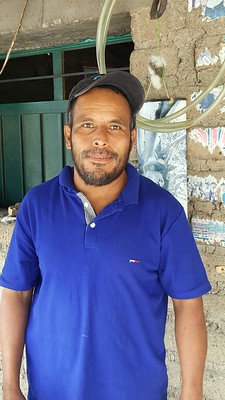 Before we left the tasting table we asked Ramon if he had anything special or unusual he thought we might want to taste and he went into the storage room and returned with a small half-filled jug of Cuixe made from the interestingly named Agave Karwinskii. It makes you wonder just who Karwinskii was and how he got involved with Mezcal. We found it a smooth flavorful taste with lots of floral tones and were happy that we still had one more empty-bottle that we had brought with us that we could fill.
Before we left the tasting table we asked Ramon if he had anything special or unusual he thought we might want to taste and he went into the storage room and returned with a small half-filled jug of Cuixe made from the interestingly named Agave Karwinskii. It makes you wonder just who Karwinskii was and how he got involved with Mezcal. We found it a smooth flavorful taste with lots of floral tones and were happy that we still had one more empty-bottle that we had brought with us that we could fill.
 After our purchase we walked a short ways from the shed and Ramon showed us specimen plantings of some of the different agaves they use for distillation and took in the amazing view of the mountains and valley that spread out in front of us.
After our purchase we walked a short ways from the shed and Ramon showed us specimen plantings of some of the different agaves they use for distillation and took in the amazing view of the mountains and valley that spread out in front of us.
From there, we continued (with smiles on our faces) down the mountain on the old road and connected with Highway 190 in Mitla for the short drive to the village of Santiago Matatlán, the self-named “Mezcal Capital of the World”. Right alongside the road we stopped for a return visit to Mezcal Desde La Eternidad (aka Mezcal La Curva) and found our always smiling friend Master Mezcalero Juan Hernández Martinez.
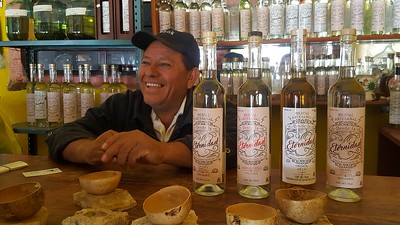
The whole family was again there to greet us and we slowly worked our way through multiple tastings. Because we tend to look for the new and unusual we didn’t buy any but we were shocked at just how much we liked the (most commonly found mezcal) Espadin Joven and were pleasantly surprised when we unpacked our box of purchases that night and found a small bottle that Sr. Juan had thrown in the box as a gift.
On our last visit here we had sampled 3 different Reposado mezcals but hadn’t bought any of those. On this day we again tasted several of those along with a muy suave two year old Espadin Anejo and we did bring one each of those home.
Sr. Juan always seems to have something new he wants us to taste and this time it was a Jabalí; made from wild grown agave Convallis, a variety that has a reputation of being difficult to work with. This one had strong fruit and smoke to nose and tongue and was distilled to 50 % ABV (vs. the typical 45%). Because of its rarity and extra work required to distill this agave, the Jabali is a bit more expensive than most varieties but we felt it was worth the cost to buy a 500 ml bottle.
While all of the above purchases were new mezcals to add to our home bar, we also were saving room in our suitcase for a liter of Sr. Juan’s “Ensemble”, a blend of Tepeztate and Tobala, which had proved to be our single most favorite bottle from our last visit.
From Mezcal Desde La Eternidad, it was a 30-second drive down the driveway located directly across the street to the showroom and distillery of Mezcal Gracias a Dios. In the time since our visit there the previous year, this place had grown significantly in terms of showroom, meeting space, in distilling capacity and even in a new guesthouse venture.
I have to say the “feel” of the place has changed a bit too.
While we were there we saw Maestro Mezcalero Óscar Hernández Santiago connecting tubing to new stainless steel tanks but other than a nod of recognition we really didn’t get the chance to interact with him this time. He was too busy. On our first visit the year before we noticed Sr. Óscar was utilizing more modern techniques in his process than most local mezcaleros and we saw nothing that changed that impression on this visit. The neat clean space and stainless still tanks made this operation seemed more akin to a Napa Valley winery than a palenque in the hills of Oaxaca.
Something else that was new was that we were asked pay a fee for tasting. This was the first palenque we had ever visited where that had happened. I assume it was instituted to keep down serving the casual visitor with no intent of purchasing and it was a modest fee so we plunged in anyway.
For those that haven’t read our previous report, along with all the familiar varietals of mezcal, Gracias a Dios is one of the few places offering a triple distilled Agave Gin, which we tasted and loved on that prior visit. We not only bought several bottles then but found a source in the U.S. where we could buy it and have it shipped to us. Obviously, a lot of other people had discovered this product in the past year that necessitated the expansion.
We also found that in addition to the original 32 Botanics Gin, GAD now is offering 2 other Gin options. Receta Oaxaqueña uses juniper and 7 botanics from the State of Oaxaca (including avocado leaf, yerba santa, cacao and tangerine). The third is an Old Tom Gin recipe sweetened with agave juice and then aged for 3 months in oak barrels to give it a light caramel color.
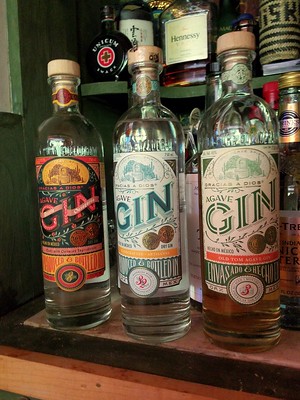
We bought a bottle of each of the 3 Gins plus a Tobala. Just out of interest, when we returned home I researched Gracias a Dios distribution in the U.S. and was amazed at the expansion of the options on obtaining GAD products at home.
Since this visit in 2019 we’ve already had the occasion to order a bottle of the original 32 from a U.S. source so we obviously like the products of GAD but given the modernization of the facility plus its expanding availability in the U.S.; we may not include it on our next visit to local distilleries. Of course that will just open the door for us to visit someplace new.

